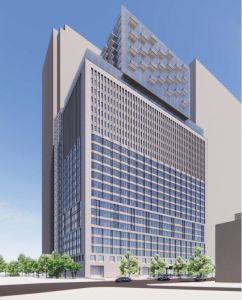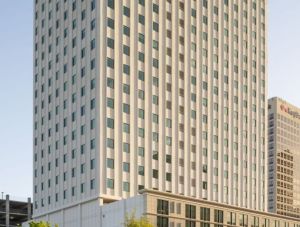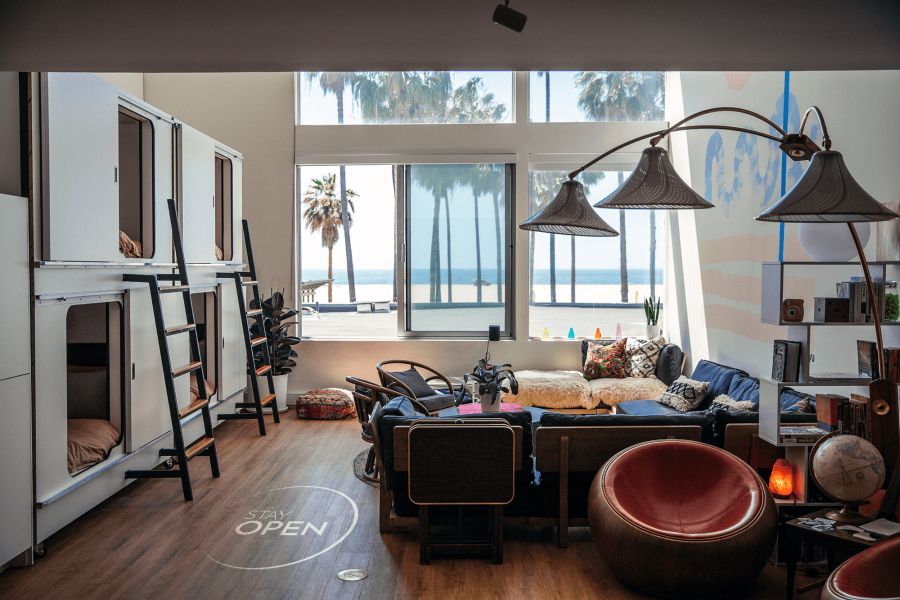How Vacant Office Spaces Get New Life
Ranging from multifamily, life science and industrial to hospitality, these makeovers are rising in number.
A sea change of sorts is upon the office sector, and much like the leading cause of the shift—the remote-work trend—there is no stopping it.
With an increasing amount of vacant office space hitting the market as companies rethink their real estate needs in the post-pandemic environment, more commercial real estate industry players are pursuing repurposing projects to capitalize on the unutilized workspace square footage. Multifamily, industrial, life science, hospitality—the conversion options are diverse, and the number of projects is on the rise.
The proof of the office sector’s transition is in the numbers. In the third quarter of 2022, the national office vacancy rate climbed to 17.1 percent, the highest level in 30 years, according to a report by CBRE. Tenants are still leasing space, but they are, quite frequently, leasing smaller spaces.
“We’re seeing quite a bit of rightsizing that’s happening in the market, and we do expect that vacancy is going to edge higher over next several quarters,” Jessica Morin, Americas head of office research, with CBRE, told Commercial Property Executive.
While there has certainly been a great deal of talk in the market about office conversions amid the pandemic-induced drop in occupancies, the actual number of completed conversions hasn’t increased very much over the last few years. CBRE found that, on average, the U.S. recorded a total of 39 completed office conversion projects annually between 2017 and 2021. However, it appears that the market has reached a turning point, with all the rumblings about office repurposing possibilities translating into a notable increase in conversion completions. As of the start of December 2022, 42 office conversions had reached completion and 217 were either underway or planned. Of the underway developments, 21 projects were scheduled to come online by the end of 2022, according to CBRE.
(Not) suitable for converting
While there are a bevy of potential adaptive reuse options for office properties, not every occupancy-challenged building is conducive to conversions. As office users continue to right-size, they are seeking not only smaller spaces with more efficient use of square footage, but also higher quality accommodations with a roster of premier amenities designed to attract and retain top talent. Thus, most Class A office properties have not been targets for repurposing projects, and rightsizing or not, they are unlikely to be pinpointed for conversions even as vacancies rise.
READ ALSO: Top 10 Commercial Real Estate Trends for 2023
“Class A buildings, I believe, will largely remain intact,” Sal Guatieri, senior economist & director with BMO Capital Markets, told CPE. “More businesses will need less office space, but they will prefer to have the best space possible. They want to get more of the workers back to the office more often, and to do that you have to offer a pretty attractive location that meets all the needs of today’s modern worker. Technology needs in particular and, of course, some of the social needs.”
However, Class A office assets—the majority of which have been developed in or after 2010—account for only an estimated 9.2 percent of the national office market, according to CBRE, leaving a sizeable amount of Class B and C space vulnerable to rising vacancy levels. But Class C assets are unlikely to be targeted for repurposing for entirely different reasons than those that protect Class A assets from conversion projects. “These are old buildings with old plumbing, old electrical systems—it might just make sense to tear those properties down and use that land for a brand-new condo tower for example,” BMO said.
Primed for new incarnations
As the office conversion trend picks up speed, it will be assets that fall in the category of Class B that owners and investors will identify for conversion projects. According to CBRE, 30 percent of U.S. office buildings were developed before 1980, and this segment of the national office inventory recorded a vacancy rate of 17 percent in December. In places like metropolitan Washington, D.C., a growing number of owners of the most “demand-challenged” Class B office assets are considering the value proposition of these properties for non-office use, Newmark notes in a winter 2022/2023 research report.
Historically, the majority of office buildings tapped for conversion have been transformed into multifamily properties, followed by life science projects and then hotel projects, with industrial projects ranking a distant fourth. The prevalence of office-to-multifamily conversions has been on the rise since the pandemic—skyrocketing 43 percent from 2018-2019 to 2020-2021, according to Yardi Matrix research—and the trend appears destined to continue, with investors eager to capitalize on the low vacancy rates and soaring rents in the multifamily sector.
Additionally, the call for more office-to-multifamily conversions is growing increasingly loud as communities across the country struggle with inadequate housing. Many local officials see vacant office buildings as a potential solution to the mounting need for affordable housing. However, the viability of a conversion project extends beyond the feasibility of adding bathrooms and kitchens to a building that already has the requisite square footage for residential living. Morin noted, “The conversions that are happening are in the luxury tier because you need the rent to make the cost attractive for investors to do a conversion, so we’re not seeing a lot of the affordable conversions.”
READ ALSO: Top 5 Southeast Markets for Office Deliveries
For developers drawn to the multifamily sector’s attractive fundamentals, low-occupancy office properties with corresponding value-add price tags are like catnip. In June 2022, Hines acquired South Temple Tower, a 51 percent occupied office asset in downtown Salt Lake City, for the sole purpose of transforming the 217,000-square-foot, 1960s-era building into a luxury multifamily property. Hines plans to break ground on the project, the company’s first-ever office-to-multifamily conversion, in the first quarter of 2023, with the goal of delivering 255 residential units and ground-level retail at the 24-story building.

Rendering of completely repurposed 25 Water Street, New York City, from office to residential. Image courtesy of CetraRuddy
And in what industry experts have identified as the largest office-to-residential conversion transaction in U.S. history, GFP Real Estate, Metro Loft Management and Rockwood Capital secured a $535.8 million loan in late December 2022 for the acquisition and redevelopment of 25 Water Street, a 1.1 million-square-foot Manhattan office high-rise originally developed in 1968. The borrowers will utilize approximately $250 million of the loan for the purchase of the building previously known as 4 New York Plaza, where former anchor tenant JPMorgan put its entire 700,000-square-foot space on the market for sublet earlier in 2022. With the remaining loan proceeds, GFP and partners plan to transform the 22-story building into a 1,300-unit residential rental property with such highly coveted amenities as indoor and outdoor swimming pools, a sky lounge and landscaped rooftop terrace.
“I would think the majority of unused office space will be used for living space, especially in the downtown of large cities where the land is very expensive and a lot of young people like to live still,” Gualtieri said. “Even though they may not want to go into the office five days a week, they still want to live in the downtown of a large city with all the amenities.”
Sector leapfrog
Although multifamily has long been the leading choice for office conversions, the sector may soon drop to second place. Of the 125 CBRE-tracked office conversion projects currently underway, 50 percent are being redeveloped as life science destinations. “That’s really driven by growth in the life science space over the past few years, and then really high demand for those spaces and attractive rent roll,” Morin explained.
Office-to life science conversions are a different beast. Lab tenants require substantial infrastructure, much more so than multifamily occupants, rendering such conversions an expensive endeavor. HVAC systems, clean rooms and loading docks—all requisite components of a life science property—necessitate high ceilings, not often found in office properties. Additionally, life science properties incorporate higher levels of mechanical, electrical and plumbing engineering. However, the return on these big-ticket transformations can be worth the investment. In the third quarter of 2022, the asking rent for lab space increased 6.8 percent in the top 12 U.S. markets, reaching an average of more than $60 per square foot, according to CBRE research.
READ ALSO: Exploring Redevelopment Opportunities Within Life Sciences
The rise in office-to-life science projects will continue to be geographically driven, with the majority of transformations taking place in the tightest life science clusters, including the Boston/Cambridge market, which remains the leading life science hub in the U.S. The average vacancy rate for lab/R&D properties is 1.2 percent in Cambridge and less than 1 percent in Boston proper, according to third quarter 2022 figures from CBRE. And of the 71 life science projects in the pipeline in the Boston/Cambridge market, 36 are conversion undertakings.
Secondary viabilities
Before the COVID-19 health crisis wreaked havoc on the hospitality sector, office-to-hotel conversions were more popular undertakings than they are now. “[The change] is really just due to lower business travel and lower office attendance because hotel and office definitely are property types that move in tandem together in their metrics,” Morin said.
The transformation of office buildings to hotel properties appears to be destined to continue on the downswing for the foreseeable future due to a trifecta of challenging circumstances. The practicality of office-to-hotel conversions is dwindling amid rising construction expenses, increasing financing costs and the inextricable link between office visitation and business travel demand, particularly as remote work takes hold as a new norm rather than a passing trend.
Of the small percentage of office-to-hotel conversions underway, according to the CBRE report, the majority are relying on added financing in the form of subsidies and incentives or are incorporated into mixed-use projects as just one element of a larger, multi-faceted development. Challenges notwithstanding, some developers are finding the right combination of conditions conducive to transforming underutilized office structures into hotels.
In December 2022, Shivom LLC acquired the vacant office building at 124 E. Olympic Blvd. in downtown Los Angeles and announced plans to transform the approximately 70,700-square-foot property into a 149-key hotel. The structure, sited in the burgeoning Fashion District submarket, is already entitled for redevelopment as a hotel, courtesy of the previous owner. The lodging destination will operate under the Paris-based Mama Shelter brand and will feature an array of luxury amenities, food & beverage offerings in a unique boutique hotel environment.
READ ALSO: Tech Slowdown Weighs on Office Sector
Stay Open believes at least a portion of the hotel industry’s future centers on vacant-office inventory, and more than a few investors concur. The startup, which converts unused commercial office space into affordable pod hotels, was able to raise $2 million in seed funding during the height of the pandemic in 2020. In 2021, Stay Open revealed its inaugural property along the waterfront in Venice Beach, Calif., offering 10 pods in the repurposed, Frank Gehry-designed lodging destination.
“We really built this business to think about how to reposition obsolete office and retail,” Andrew Swerdloff, COO & co-founder of Stay Open, told CPE. “We saw the writing on the wall prior to COVID and recognized that a lot of this office space was going to be vacant. COVID just accelerated a process where owners have realized that for a vast majority of their staff, they can do remote work and they don’t need these large office floorplates that cost businesses lots of money.” Stay Open takes unused spaces of 10,000 to 20,000 square feet and fits them out to accommodate the sleeping pods, as well as spaces for work, play, experiences, and at some locations, food & beverage outlets.
Stay Open has proven a successful model; the Venice location operates at an average 90 percent occupancy. And the company believes the office market’s challenges will present a new opportunity in the real estate industry. Stay Open endeavors to evolve into a space-as-a-service provider offering a turnkey solution to owners of obsolete office and retail space, where the company will provide the toolkit for conversion and then manage and operate the asset as a third party.
READ ALSO: How a Looming Recession Impacts CRE Deals
Swerdloff concedes that there is still a certain unwillingness among some office property owners to accept the fate of their Class B and C assets in the new office market reality. “Owners of real estate will only start to really think about new directions of their space if they’re forced to,” he asserted. “For the last 10 years, we’ve been in this insanely low-interest rate environment. And if you were a property owner that had a tenant you did really, really well. We’re now kind of shifting out of that and it’s really only when a lot of the pain and suffering comes in that these owners will start to look at models to make their real estate more successful.
A niche opportunity
With the industrial sector still firing on all cylinders, many developers in top markets are seeking new options to create logistics space in response to strong demand. However, the conversion of office buildings to logistics properties is not destined to be a trend, even in the tightest of industrial markets. “Industrial conversions have happened, but not to the degree of multifamily, life sciences and hotel,” Morin said.
Compared to multifamily, life science and hotel properties, industrial projects require a significant amount of land, with most projects necessitating a minimum of 8 acres, as noted in a report by Prologis.
“In suburban areas and more rural regions, those office buildings will probably be converted more toward warehouse space and distribution space. The land is much, much cheaper in those regions so it’s more conducive for warehousing space,” Gualtieri said.
Additionally, the pool of office buildings that meet the criteria for industrial development is limited. Office buildings are traditionally located in areas near a skilled workforce as opposed to the transportation infrastructure that is essential for industrial assets, according to the Prologis report. Some [defunct office buildings] will be for warehouse and distribution space, especially last-mile solutions for online sellers,” he added.
Location is also a key issue in office-to-industrial conversions, as the high conversion price tags that accompany these projects can only be justified by substantially high rents, which are found in the top-tier, land-constrained markets. Still, with all the challenges that come with office-to-industrial conversions, some developers are able to find the perfect storm for such pursuits. In mid-2022, Atlas Capital acquired the single-story office building at 19401 S. Vermont Ave. in the suburban Los Angeles city of Torrance, Calif., for $39.8 million. Upon the expiration of short-term leases in the building, which sits in an industrial-friendly zone near several freeways, Atlas plans to transform the single-story structure into Class A industrial product.
Change but not a gamechanger
While the national overall vacancy rate is forecasted to peak at approximately 19 percent by the first quarter of 2024, according to CBRE, the office market will ultimately be left with a certain amount of non-viable assets, so conversions will play a greater role in the sector.
“We work with the assumption that there’ll probably be up to 20 percent less need for office space over the next few years compared to before the pandemic. So that’s a pretty large chunk of the market that either needs to be repurposed or will simply disappear,” Gualtieri said.
Additionally, the pace of conversions will likely pick up as rules and regulations begin to accommodate the inevitable growth in unused office space. Morin said, “As the subject gets discussed more and as different parties understand the challenges around it, I think we will see some additional incentives or tools or policies that make conversions a little bit more attractive.”
Ultimately, however, repurposing is unlikely to alter the face of the office sector. “While it looks like we have quite an increase, it’s still a very small fraction of the market and it’s not really going to be this single solution or a market-moving solution for U.S. office,” Morin concluded.









You must be logged in to post a comment.